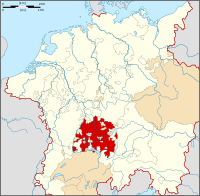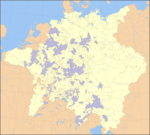- Neresheim Abbey
-
Imperial Abbey of Neresheim
Reichsabtei NeresheimImperial Abbey of the Holy Roman Empire ← 
1764–1802  →
→Capital Neresheim Abbey Government Principality Historical era Middle Ages - Abbey founded as
fief of Dillingen
1095- Oettingen claimed
Vogtei on Dillinger
extinction
1258- Albertus Magnus
settled in favour
of Augsburg
1263- Oett.-Wallerstein
sued for Vogtei
1583 and 1739- Gained Reichsfreiheit 1764 - Secularised to
Thurn und Taxis
1802- Mediatised to Bavaria 1806 - Mediatised to
Württemberg
1810Neresheim Abbey or the Abbey of Saints Ulrich and Afra, Neresheim (German: Abtei Neresheim or Abtei der heiligen Ulrich und Afra) is located above the town of Neresheim in Baden-Württemberg, southern Germany. It is now a Benedictine monastery and is part of the Beuronese Congregation.
Contents
First foundation
It was founded in 1095 as a monastery of the Augustinian Canons and changed to a Benedictine abbey in 1106.
In the 13th century, the abbey owned seven villages and it had an income from a further 71 places in the area. Ten parish churches were incorporated. During wars and conflicts the monastery was destroyed several times for example during the Thirty Years' War and during Napoleonic Wars of the beginning of the 19th century
The present abbey church was built between 1747 and 1792 to plans by Balthasar Neumann. The abbey appeared on the reverse of the 50 Deutsche Mark banknote current between 1998 and 2002, (the obverse showed Balthasar Neumann). The abbey was dissolved during the secularisation of 1803 and transferred to Thurn und Taxis until 1806 due to the Napoleoic invasion.
Second foundation
In 1802 the monastery was closed as a consequence of secularization. The Duke of Thurn and Taxis then the state of Bavaria and finally Württemberg became the owner. Precious objects were bought from Thurn and Taxis by Bavaria. It was the Duke of Thurn and Taxis who made it possible to reopen the monastery in 1919. The first abbot was Bernhard Durst (1921–65). In 1919, the abbey was resettled by Benedictines from Beuron Archabbey and the Emaus Abbey in Prague.
The church
The medieval monastery had a roman basilica but in 1695 it was transformed to a baroque church. The present abbey was erected between 1747 and 1792 from plans by Balthasar Neumann. After his death in 1753 his disciples and followers continued his work. It is a masterpiece of European baroque. its famous ceiling paintings were by Martin Knoller from Steinach, Austria. They shows Jesus Christ in the centre surrounded by scenes from his life.
The abbey today
Today there are 13 monks in the monastery, Norbert Stoffels having been their guiding abbot since 1977. There is a bookshop and a restaurant for visitors.
The monks run a conference centre and guesthouse, and offer courses and spiritual training. In 2004, the monastery set up the Neresheim Abbey Boys' Choir, which provides a free musical education and voice training. The choir sings regularly at services in the abbey church at Neresheim and also makes appearances outside the monastery.
In May 2010 the car of a kidnapped, later murdered person was found in the monastery yard. Visitors who took pictures in the period some days before and after May 13 were asked to contact the German police.
Pictures
External links
- (German) Neresheim Abbey Homepage
- (German) Neresheim Abbey information
- (German) Index of abbeys in Württemberg
 Holy Roman Empire — Imperial abbeys of the Swabian College
Holy Roman Empire — Imperial abbeys of the Swabian CollegeImperial abbeys and colleges
(Reichsabteien, Reichsklöster
und Reichsstifte)Baindt • Comburg • Disentis • Elchingen • Frauenchiemsee • Fraumünster • Fürstenfeld • Gengenbach • Göss • Gutenzell • Heggbach • Helmarshausen • Herrenalb • Irsee • Kaisheim† • Lindau • Lorsch • Marchtal • Marmoutier • Maulbronn • Mönchrot • Mondsee • Murbach* • Neresheim • Ochsenhausen • Ottobeuren • Petershausen • Prüfening • Reichenau • Roggenburg • Rottenmünster • St. Gall's* • St. George's in Isny • Salem • Schänis • Schussenried • Schuttern • Söflingen • Ursberg • Waldsassen • Weingarten • Weissenau • WettenhausenImperial charterhouse
(Reichskartause)- Also a Prince of the Empire † Also in Rhenish College
Coordinates: 48°45′21″N 10°20′37″E / 48.75587°N 10.34366°E
Categories:- Imperial abbeys
- Former principalities
- Former countries in Europe
- States of the Holy Roman Empire
- States and territories established in 1764
- States and territories disestablished in 1802
- Monasteries in Baden-Württemberg
- Christian monasteries established in the 11th century
- Augustinian monasteries in Germany
- Benedictine monasteries in Germany
Wikimedia Foundation. 2010.







